
Arizona’s Red Rock Country Oak Creek River parallels HW 89A curving through miles of breathtaking canyon vistas and shady oak forests between Flagstaff on the North and Sedona on the South.
 But on Sunday Oak Creek Canyon reminds me of ants at a summer picnic. Sedona tourism has tripled in the last decade with over two million annual visitors. On any given weekend thousands pack the roadway, parking lots overflow both sides of the highway, and bumper-to-bumper one-lane traffic inches through the gridlock. The highway flows into downtown Sedona and every artery is an organized bottleneck thanks to abundant roundabouts.
But on Sunday Oak Creek Canyon reminds me of ants at a summer picnic. Sedona tourism has tripled in the last decade with over two million annual visitors. On any given weekend thousands pack the roadway, parking lots overflow both sides of the highway, and bumper-to-bumper one-lane traffic inches through the gridlock. The highway flows into downtown Sedona and every artery is an organized bottleneck thanks to abundant roundabouts.
Yet even here you can camp alone for free with spectacular views of colorful cliffs, soaring pinnacles, juniper and pinion forests, and abundant wildlife.

If you’re willing to take the roads less traveled.
It’s 20-30 minute drive from town to campsite. The road is part gravel with some wash boarding, but is very passable. (In a rain the mud becomes goo so plan to settle in and wait for things to dry out rather than bog your rig in headache and heartbreak.)
 Take HW 89A west from Sedona to mile marker 365. Turn right on Forest Rd 525 – Red Canyon Road. From entry to Palatki Ruins are many clearly marked pullouts. Some can accommodate numerous rigs while others are perfect for a small tent.
Take HW 89A west from Sedona to mile marker 365. Turn right on Forest Rd 525 – Red Canyon Road. From entry to Palatki Ruins are many clearly marked pullouts. Some can accommodate numerous rigs while others are perfect for a small tent.
I prefer the area north of the Boynton Pass Road between the Honanki and Palatki Heritage Sites. Nestled in Lincoln Canyon of Red Rock Secret Mountain Wilderness you are encircled by the  Mongollon Rim with Secret, Bear, and Lost Mountains on the east and Black, Sugarloaf, and Casner Mountains on the north and west.
Mongollon Rim with Secret, Bear, and Lost Mountains on the east and Black, Sugarloaf, and Casner Mountains on the north and west. Like all of Sedona it can get crowded and it’s worth venturing past the first spots. The area has many OHV trails so the biggest drawback is abundant Jeep and ATV traffic during business hours.
Like all of Sedona it can get crowded and it’s worth venturing past the first spots. The area has many OHV trails so the biggest drawback is abundant Jeep and ATV traffic during business hours.

But sunrise and sunset offer gorgeous slivers of solitude and silence in stunning natural beauty and fragile desert wilderness. The dark night skies envelop you in a velvet blanket of dazzling stars, planets, and galaxies 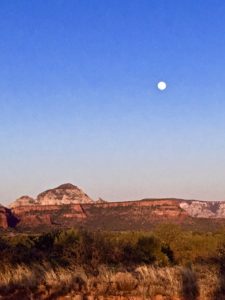 that seem close enough to touch.
that seem close enough to touch.
There are other dispersed camping sites closer to town, but like the private RV parks they appear to remain crowded. Veteran boondockers say many of these sites are in the process of being temporarily/permanently closed. Even the dispersed camping sites on forest roads are becoming sparse as forest officials try to balance human access with protection of natural resources.
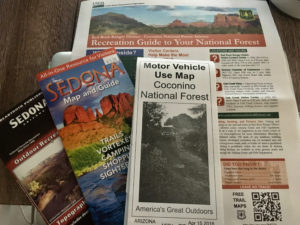 Motor Vehicle Use maps show dispersed camping options in Coconino National Forest. Be sure to get a new map as many areas have closed. These are available at any of the three visitor centers – Red Rock Visitor Center, the Sedona Chamber of Commerce Visitor Center, and Oak Creek Canyon Visitor Center. Also look for the free recreations guides for area maps, hiking trails, plant and wildlife guides. The Sedona Outdoor Recreation Map by Beartooth Publishing is an excellent waterproof, topo shaded relief map. (Oak Creek Visitor Center has copies for $11.95. Amazon is $17.95)
Motor Vehicle Use maps show dispersed camping options in Coconino National Forest. Be sure to get a new map as many areas have closed. These are available at any of the three visitor centers – Red Rock Visitor Center, the Sedona Chamber of Commerce Visitor Center, and Oak Creek Canyon Visitor Center. Also look for the free recreations guides for area maps, hiking trails, plant and wildlife guides. The Sedona Outdoor Recreation Map by Beartooth Publishing is an excellent waterproof, topo shaded relief map. (Oak Creek Visitor Center has copies for $11.95. Amazon is $17.95)
Other Camping Options
The Forest Service operates Pine Flat, Cave Springs, and Manzanita Campgrounds along Hwy 89A north of Sedona in Oak Creek Canyon. Pine Flat and Cave Springs are open seasonally, and Manzanita is open year round for tent camping only.

South of Sedona are Arizona State Park Dead Horse Ranch and National Forest Service camps Clear Creek and Chavez. These are all open year round.
 National Forest campsites are larger than the private RV parks, but remain booked solid. National Forest camps are reservable at (877) 444-6777 or rec.gov. Dead Horse can be reserved at (520) 586-2283 or azstateparks.itinio.com/deadhorseranch. Some sites are walk up reservations. Best time to secure those is early on Sunday through Wednesday.
National Forest campsites are larger than the private RV parks, but remain booked solid. National Forest camps are reservable at (877) 444-6777 or rec.gov. Dead Horse can be reserved at (520) 586-2283 or azstateparks.itinio.com/deadhorseranch. Some sites are walk up reservations. Best time to secure those is early on Sunday through Wednesday.
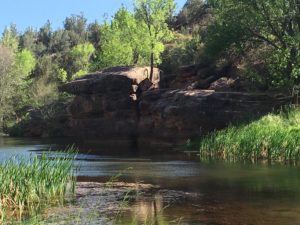
The best private camping option I’ve found is Camp Avalon. Once an organic farm Camp Avalon is now a nonprofit spiritual retreat center with private, “dry” camping options by Oak Creek. There are fire vaults and portable toilets.  It can accommodate small RV’s and tent campers on acres of open pasture and forested shade. Rates range from $20-$35/day. Camp Avalon is located at 91 Loy Lane in West Sedona off of 89A. Reservations available at www.avalon.camp.
It can accommodate small RV’s and tent campers on acres of open pasture and forested shade. Rates range from $20-$35/day. Camp Avalon is located at 91 Loy Lane in West Sedona off of 89A. Reservations available at www.avalon.camp.
Passes
 The hiking trails of Sedona are some of the nations best so it’s worth the realities of camping in a heavy tourist area. The Red Rock Pass is required in most trailhead parking lots. A one-day pass is $5.00, a weekly pass is $15.00, and an annual pass is $20.00. The Coconino National Forest Recreation Guide also lists the few areas where the pass is not valid and an additional $9.00 per-vehicle parking fee is required.
The hiking trails of Sedona are some of the nations best so it’s worth the realities of camping in a heavy tourist area. The Red Rock Pass is required in most trailhead parking lots. A one-day pass is $5.00, a weekly pass is $15.00, and an annual pass is $20.00. The Coconino National Forest Recreation Guide also lists the few areas where the pass is not valid and an additional $9.00 per-vehicle parking fee is required.

The Federal Interagency Recreation Passes are honored. These annual passes are honored at most federal forest fee areas and many other federal fee sites. The annual pass is $80, or $10 for seniors (62 and up), free for any US citizen who is disabled and any active duty military and/or dependents. The “Every Kid in a Park Pass” is free to any us 4thgrader and accompanying passengers in a private vehicle.


 Home to abundant wildlife, wild grasses, hardwoods and evergreen junipers, the canyon also holds the memories and artifacts of 12,000 years of human habitats. A little over 200 years ago the native Southern Plains tribes were decimated and relocated to reservations in Oklahoma. Wild buffalo were slaughtered to make way for a few white barons and their herds of longhorn cattle.
Home to abundant wildlife, wild grasses, hardwoods and evergreen junipers, the canyon also holds the memories and artifacts of 12,000 years of human habitats. A little over 200 years ago the native Southern Plains tribes were decimated and relocated to reservations in Oklahoma. Wild buffalo were slaughtered to make way for a few white barons and their herds of longhorn cattle. This is a great state park in winter, spring, and fall. (Summer heat and humidity can be a bit much.)
This is a great state park in winter, spring, and fall. (Summer heat and humidity can be a bit much.) vegetation for shade and privacy. Abundant wildlife gathers at the creek running along the cliffs at the back of the canyon.
vegetation for shade and privacy. Abundant wildlife gathers at the creek running along the cliffs at the back of the canyon.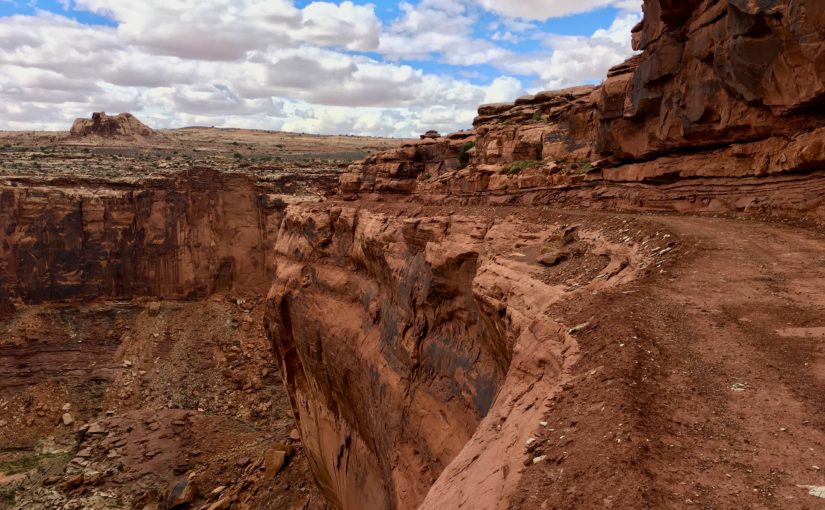
 Following trails that beckon is life at it’s best. Free wandering with no schedule or goals has served me well since childhood exploring creeks and prairies. I’ve been trained to watch and wait for the guidance but I’ll admit there’s is a new learning curve with the addition of the off-road teardrop camper. It’s keeping my guardian angels – and me – wide awake.
Following trails that beckon is life at it’s best. Free wandering with no schedule or goals has served me well since childhood exploring creeks and prairies. I’ve been trained to watch and wait for the guidance but I’ll admit there’s is a new learning curve with the addition of the off-road teardrop camper. It’s keeping my guardian angels – and me – wide awake.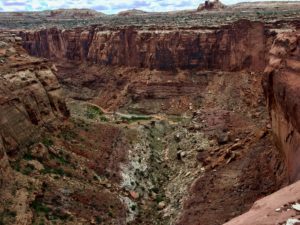 Narrow, ridiculously steep grade, no safety rails and the most amazing, adrenaline-inducing experience calling my name! The Subaru and teardrop had torn up off roads for days and I was primed for the grand prize dive down The Canyon.
Narrow, ridiculously steep grade, no safety rails and the most amazing, adrenaline-inducing experience calling my name! The Subaru and teardrop had torn up off roads for days and I was primed for the grand prize dive down The Canyon.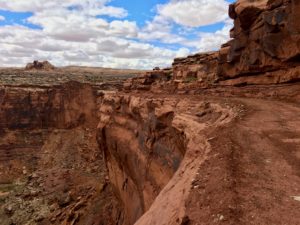 Perhaps a bit of recon was in order. Rapid, shallow breathing and heart-pounding adrenaline with knees bent, eyes straight ahead helped resist the abyss tractor beam pulling me over the edge on the switchback curves. Barely. There was just enough width for the car and RV. No margin for error, changing my mind or turning around. There might be a clearance and mud issue. But I was a hound dog on a scent. Ride The Canyon or bust!
Perhaps a bit of recon was in order. Rapid, shallow breathing and heart-pounding adrenaline with knees bent, eyes straight ahead helped resist the abyss tractor beam pulling me over the edge on the switchback curves. Barely. There was just enough width for the car and RV. No margin for error, changing my mind or turning around. There might be a clearance and mud issue. But I was a hound dog on a scent. Ride The Canyon or bust!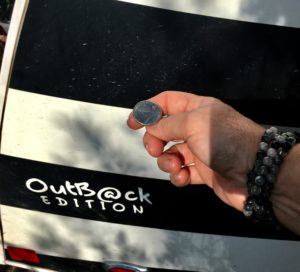 Time to pull out the big guns and use a technique honed over eight years in the halls of MD Anderson Cancer Center. Call in my angels when stakes are life OR death high. Employ the hallowed Coin Toss. Best two out of three wins. Heads means I go for it, tails I turn around and find a camp for the night.
Time to pull out the big guns and use a technique honed over eight years in the halls of MD Anderson Cancer Center. Call in my angels when stakes are life OR death high. Employ the hallowed Coin Toss. Best two out of three wins. Heads means I go for it, tails I turn around and find a camp for the night.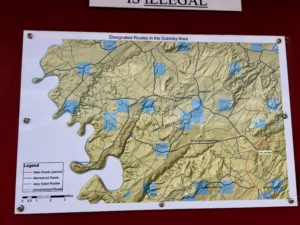 My best guess is I was in the Sheep Canyon area. GPS noted Mineral and Dead Horse Point Roads. I found an OHV trail map sign post indicating I was somewhere in the Dubinky area. Maybe The Canyon was a piece of Hell Roaring or Chicken Corners Trails. The coin toss occurred at the point requiring gate entry, is pinched between rocks on the right and the abyss on the left and drops over 1,000 feet via narrow, rocky, muddy switchbacks. Chicken Corners is where Moab area guides allow “chicken” passengers to walk, rather than ride. And Hell Roaring Canyon descriptions involve the word “pucker.”
My best guess is I was in the Sheep Canyon area. GPS noted Mineral and Dead Horse Point Roads. I found an OHV trail map sign post indicating I was somewhere in the Dubinky area. Maybe The Canyon was a piece of Hell Roaring or Chicken Corners Trails. The coin toss occurred at the point requiring gate entry, is pinched between rocks on the right and the abyss on the left and drops over 1,000 feet via narrow, rocky, muddy switchbacks. Chicken Corners is where Moab area guides allow “chicken” passengers to walk, rather than ride. And Hell Roaring Canyon descriptions involve the word “pucker.”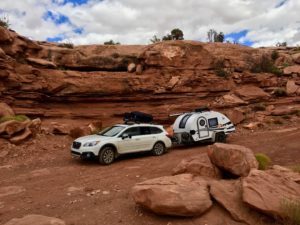 I probably have too much faith in Beverly (my Subaru Outback) but I think she’d make The Canyon. Pulling my Outback teardrop camper affectionally dubbed Hillbilly? Sheer lunacy.
I probably have too much faith in Beverly (my Subaru Outback) but I think she’d make The Canyon. Pulling my Outback teardrop camper affectionally dubbed Hillbilly? Sheer lunacy.